- Hispanoamérica
- Work at ArchDaily
- Terms of Use
- Privacy Policy
- Cookie Policy
- Cultural Architecture

Asakusa Culture and Tourism Center / Kengo Kuma & Associates

- Curated by ArchDaily
- Architects: Kengo Kuma & Associates
- Area Area of this architecture project Area: 234 m²
- Year Completion year of this architecture project Year: 2012
- Photographs Photographs: Takeshi Yamagishi
- Architects: Kengo Kuma & Associates
- Design Team: Kengo Kuma, Teppei Fujiwara, Masafumi Harigai, Okayama Naoki, Kiyoaki Takeda, Masaru Shuku, Erina Kuryu, Hiroaki Saito
- City: Tokyo
- Country: Japan

Text description provided by the architects. In the corner premise of just 326㎡ across Kaminari-mon Gate, the building was required to accommodate plural programs such as tourist information center, conference room, multi-purpose hall and an exhibition space.

The center extends Asakusa’s lively neighborhood vertically and piles up roofs that wrap different activities underneath, creating a “new section” which had not existed in conventional layered architecture. Equipments are stored in the diagonally shaped spaces born between the roof and the floor, and by this treatment we could secure large air volume despite its just average height for high-and medium-rise buildings.

Furthermore, the roofs not only divide the structure into 8 one-storied houses but also determine the role of each floor. First and second floor has an atrium and in-door stairs, creating a sequence from which you can feel the slope of the two roofs.

On 6th floor, taking advantage of the slanted roof, we were able to set up a terraced floor with which the entire room can function as a theater. As angles of the roofs inclined toward Kaminari-mon and the heights from the ground vary from floor to floor, each floor relates differently to the outside, giving a unique character to each space.

Project gallery

Materials and Tags
- Sustainability
想阅读文章的中文版本吗?

浅草文化旅游信息中心 / Kengo Kuma & Associates
You've started following your first account, did you know.
You'll now receive updates based on what you follow! Personalize your stream and start following your favorite authors, offices and users.
Check the latest Media Stands
Check the latest Media Walls
Cart detail
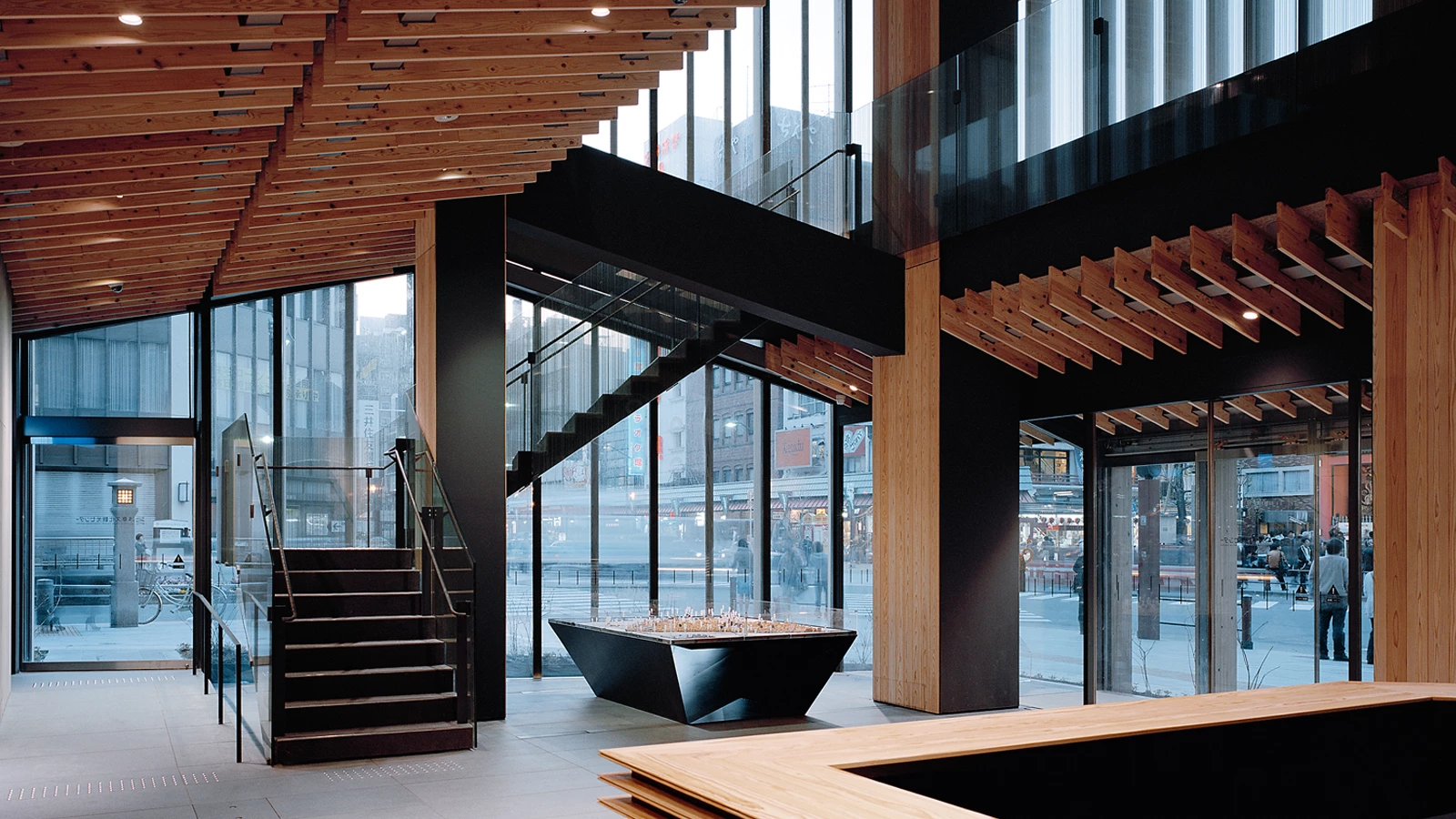
Asakusa Culture Tourist Information Center
- Typologies Commercial / Office Headquarters / office
- Material Wood
- Date 2009 - 2012
- City Tokyo
- Country Japan
- Photographer Edmund Sumner

Located across across from the Kamiari-mon Gate of the old Buddhist temple of Sens?-ji, in the busy neighborhood of Asakusa in Tokyo, the cultural and tourist information center piles up small volumes of sloping roofs, generating a non-conventional layered architecture. Each space is designed and conceived in section. In this way, every level has a single and specific space adapted to its particular function. Furthermore, the sloping roofs of the building and the floor-to-ceiling height varies from one level to another, so each floor is related in a different manner with the outdoors, giving a unique character to each area. The interstitial spaces between the stacked volumes accommodate the mechanical installations and climate control systems.
The lobby of access is located between the first and second floor, from which the diagonal circulation of the center can be perceived. On the sixth floor, the slanted roof generates a terraced space that can function as theater or conference room. To give the tower a unified image, the building is wrapped in a skin of cedar wood slats placed at different intervals depending on the lighting and privacy needs of the interior spaces, evoking traditional construction in Japan.
Cliente Client
Arquitecto Architect
Kengo Kuma & Associates
Colaboradores Collaborators
Makino Structural design (estructuras structural engineering ); Kankyo Engineering inc. (electricidad electrical engineering ); Kankyo Engineering inc. (ingeniería mecánica mechanical engineering ); Izumi Okayasu Lighting design (iluminación lighting ); Ando Yoko Design (fachada curtain design ); Tokyo Pistol (cartelería sign design )
Contratista Contractor
Fotos Photos
Edmund Sumner; Takeshi Yamagishi
Included Tags:
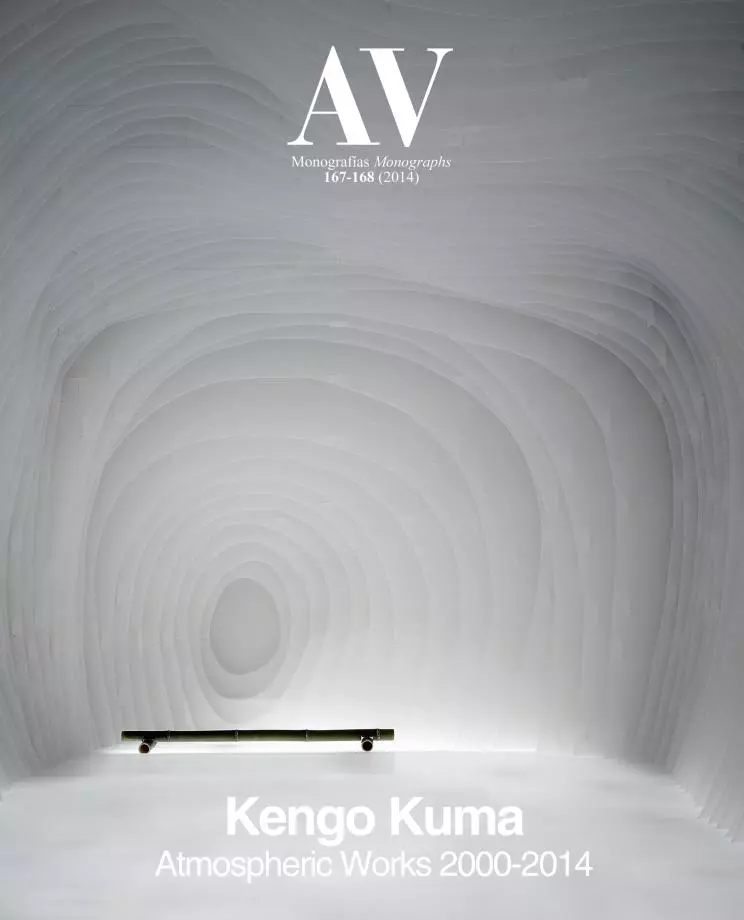
Init session and enjoy from Arquitectura Viva
Enter your username and password
Enter a valid email address
Enter your password
You need to enter at least 3 characters
Sorry, there arent any match using your search terms, please try again using other terms.
- Alphabetically
- Publications
Search tips
How to search:.
- Write your search in the text box.
- We suggest you known tags based on your text. You can use them for your text or just select 'SEARCH TEXT' .
- Your results will appear.
- You can continue adding queries to your search following steps 1 to 3 to limit the results and also filter by result type .
- Remember you can also do quoted searches for complex strings
- You also can seach by categories in our works , articles , books and products pages
Asakusa Station
Asakusa Transportation Guide
Asakusa Culture Tourist Information Center
Asakusa Culture Tourist Information Center is not just a valuable source of sightseeing advice, but one of Asakusa’s newest sightseeing attractions. The Center, which opened in April 2012, is housed in an attractive contemporary building of timber and glass that was designed by Kengo Kuma. Kuma is of course the world renowned architect who designed the New National Stadium that will be the main venue for the Tokyo Olympics in 2020. Asakusa Culture Tourist Information Center is more modest in its design and purpose, but it is still a very striking structure with the appearance of a stack of separate wooden buildings that have been piled up on top of each other at different angles.
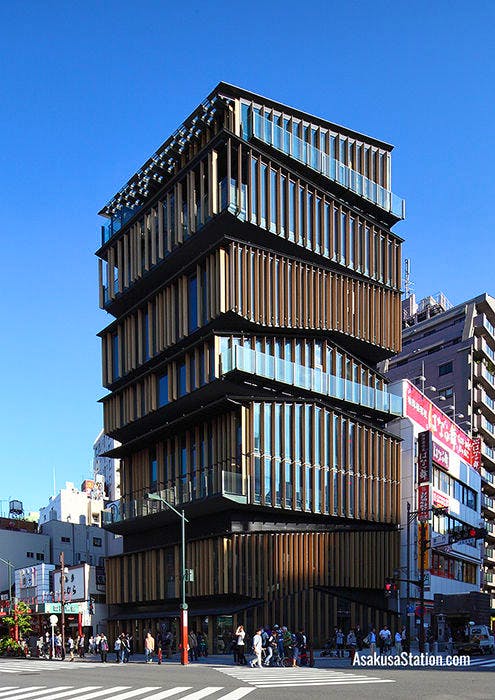
Asakusa Culture Tourist Information Center’s facilities include an information counter, an exhibition space, a café, and an observation deck. All the facilities are free to enter. The Tourist Information Center also organizes its own free English language guided walking tours of Asakusa every weekend.
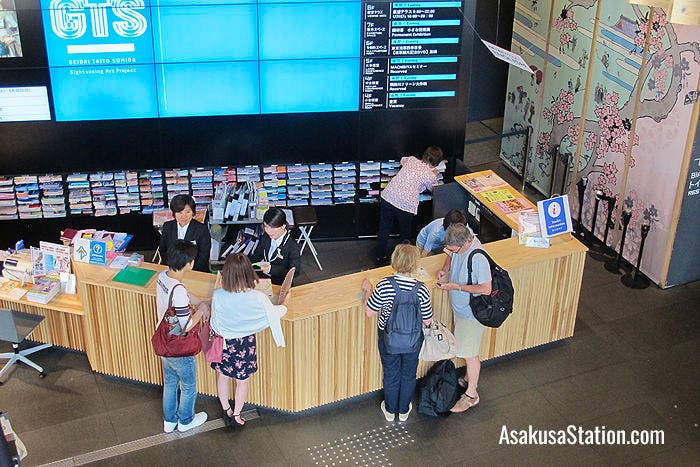
The tourist information counter
The staff at the information counter speak English, Chinese, and Korean as well as Japanese. Sightseeing maps and brochures in these languages are available and the staff will be happy to take enquiries about local sightseeing attractions, culture, and history, as well as offering advice on transport and accommodation. Staff can also provide information on cultural experiences such as cooking and kimono-wearing experiences.
Other facilities include a foreign currency exchange counter, free Wi-Fi internet access, computers that visitors can use to access the internet for free, a multipurpose toilet, and a nursing room with baby changing facilities.
From the open terrace Observation Deck on the 8th floor of the Center, you can get a good view of the Kaminarimon, with Nakamise and Sensoji Temple on one side, and on the other side is another splendid view of Tokyo Skytree and the Asahi Flame. There is also a café on the 8th floor where you can get light meals, snacks, beers and other refreshments.
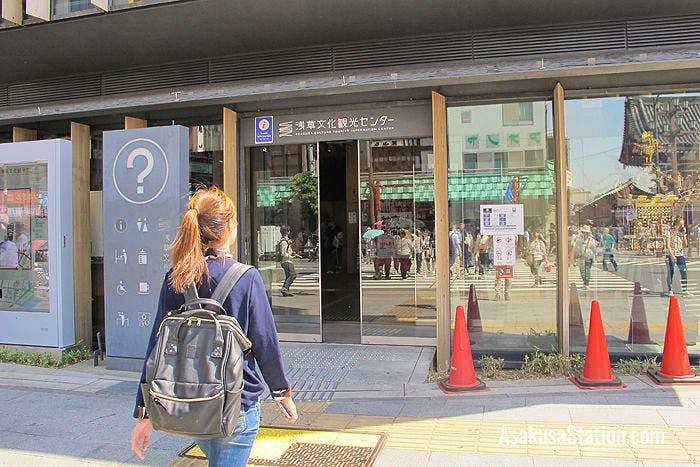
The entrance to Asakusa Culture Tourist Information Center
Asakusa Culture Tourist Information Center is located on the south side of Kaminariomon-dori Street, and is directly across from the Kaminarimon Gate.
From Exit 1 of Tokyo Metro Asakusa Station on the Ginza Line it is a 1 minute walk. From Exit A4 of Toei Asakusa Station on the Asakusa Line it is a 2 minute walk. From the Main Exit of Tobu Asakusa Station on the Tobu Skytree Line it is a 3 minute walk. From Exit A1 of TX Asakusa Station on the Tsukuba Express Line it is an 8 minute walk.
Opening Hours
Asakusa Culture Tourist Information Center is open every day from 9.00-20.00. Miharashi Café on the 8th floor is open every day from 10.00-20.00. The Observation Deck closes at 22.00.
Article by Michael Lambe. Photos by chariari/pixta (1) and Michael Lambe. All rights reserved.
Questions? Ask on our forum
Japan Station on Facebook
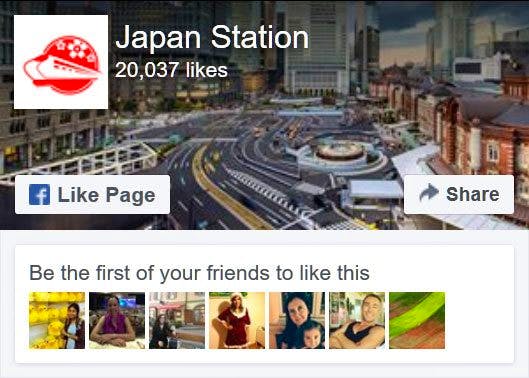
Japan Station Guides
- Yokohama Station Guide
- Ueno Station Guide
- Nikko Station Guide
- Sapporo Station Guide
- Shinjuku Station Guide
- Asakusa Station on Facebook
- Asakusa Station on Twitter
- Asakusa Station on Instagram
- Asakusa Station on Pinterest
- Japan Station Forum
Asakusa Culture and Tourism Center
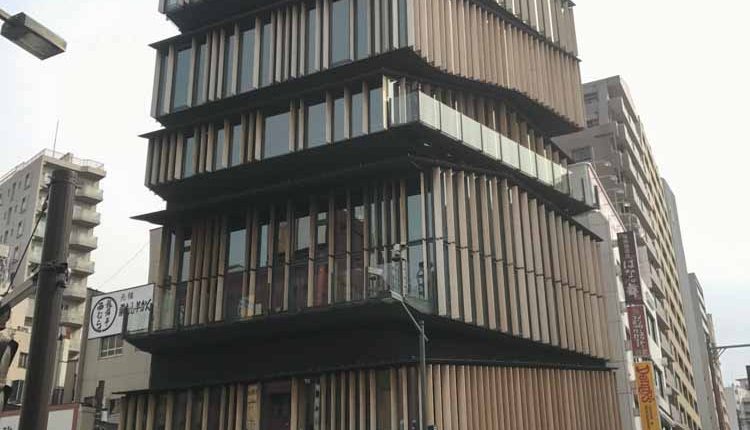
Asakusa Engei Hall
Share article.
An excellent tourist information center for the Asakusa area. The top floor is also an observation deck which provides superb views of Nakamise and Sensoji Temple . Free WiFi is also available. On the ground floor near the information desk you can also find all of Taito Ward excellent tourist maps for Asakusa and other areas of the ward such as Ueno and Yanaka .
Information
You may also like.
- Viewing Decks
I-Link Town Ichikawa
Tokyo skytree, mount inasa observation deck, yokohama landmark tower.

Asakusa Culture and Tourism Center | Kengo Kuma and Associates
Asakusa Culture and Tourism Center
In the corner premise of just 326 sqm across Kaminari-mon Gate, the building was required to accommodate plural programs such as tourist information center, conference room, multi-purpose hall and an exhibition space.
The center extends Asakusa’s lively neighborhood vertically and piles up roofs that wrap different activities underneath, creating a “new section” which had not existed in a conventional layered architecture. Equipment is stored in the diagonally shaped spaces born between the roof and the floor, and by this treatment, we could secure large air volume despite its just average height for high-end medium-rise buildings.
Furthermore, the roofs not only divide the structure into 8 one-storied houses but also determine the role of each floor. The first and second floor has an atrium and in-door stairs, creating a sequence of which you can feel the slope of the two roofs. On the 6th floor, taking advantage of the slanted roof, we were able to set up a terraced floor with which the entire room can function as a theater. As angles of the roofs inclined toward Kaminari-mon and the heights from the ground vary from floor to floor, each floor relates differently to the outside, giving a unique character to each space.
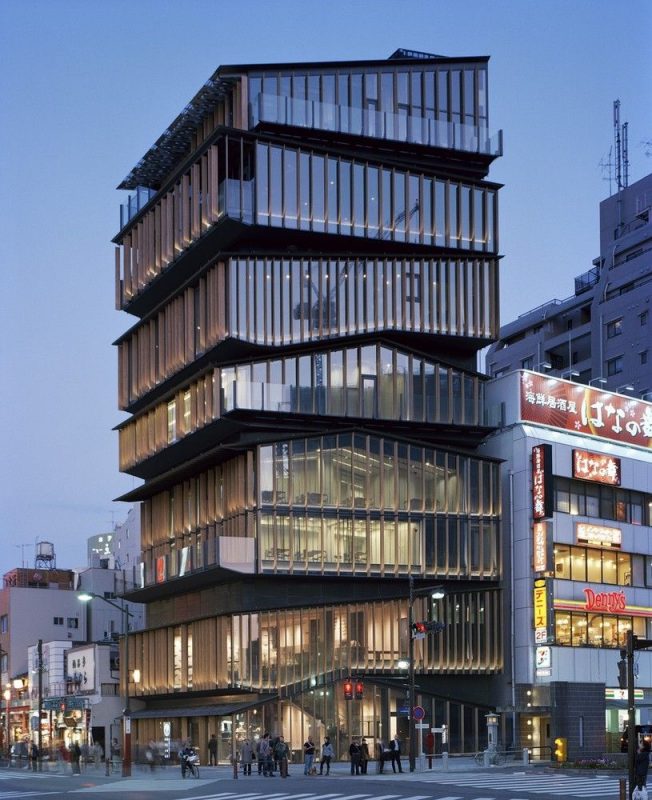
photography by © Takeshi Yamagishi
Project Info Architects: Kengo Kuma and Associates Location: Tokyo , Japan Design Team: Kengo Kuma, Teppei Fujiwara, Masafumi Harigai, Okayama Naoki, Kiyoaki Takeda, Masaru Shuku, Erina Kuryu, Hiroaki Saito Area: 234.13 sqm Year: 2012 Type: Cultural Center Photographs: Takeshi Yamagishi
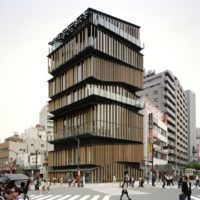
Tags: Cultural Center Japan Kengo Kuma Kengo Kuma & Associates Kengo Kuma and Associates Tokyo
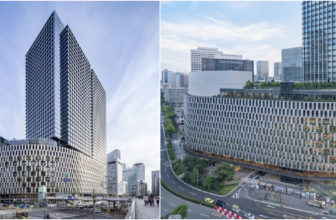
Osaka Umeda Twin Towers South | Takenaka Corporation
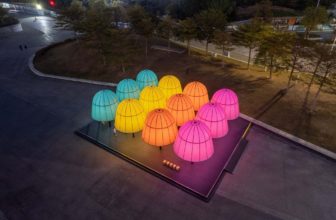
Dream Glow Pavilion | Daxing Jizi Design
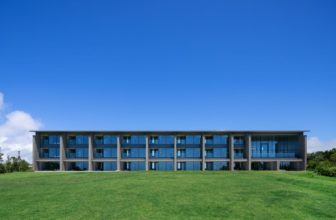
GOTO Retreat Ray | TAISEI DESIGN Planners Architects & Engineers
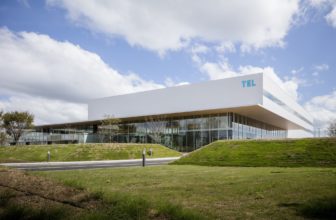
Miyagi Technology Innovation Center | TAISEI DESIGN Planners Architects & Engineers


Portal for Japanese minimalist architecture
- Residential architecture
- Cultural architecture
- Religious architecture
- Educational architecture
- Healthcare architecture
- Industrial architecture
- Institutional architecture
- Hospitality architecture
- Industrial designers
- Interior designers
- Lighting designers
- MINIMALIST architecture
- Exhibitions
- Fairs + Conferences
- Editor’s picks
- Submit your work
Generic selectors Exact matches only Search in title Search in content Post Type Selectors
Project Info
- Architects : Kengo Kuma & Associates
- Team : Kengo Kuma + Teppei Fujiwara, Masafumi Harigai, Okayama Naoki, Kiyoaki Takeda, Masaru Shuku, Erina Kuryu, Hiroaki Saito
- Location : Tokyo , Tokyo Metropolis
- Photographs : Takeshi Yamagishi
- Function : Visitor centers
- Completion : February 2012
- Floor area : 2,159.52 m² (BF + 8F + RF)
- Material : Steel , Wood
Asakusa Culture Tourist Information Center | Kengo Kuma & Associates
Words by mooponto Staff
July 8, 2012

In the corner premise of just 326 m² across Kaminari-mon Gate, the building was required to accommodate plural programs such as a tourist information center, conference room, multi-purpose hall, and exhibition space.
The center extends Asakusa ’s lively neighborhood vertically and piles up roofs that wrap different activities underneath, creating a “new section” which had not existed in a conventional layered architecture. Pieces of equipment are stored in the diagonally shaped spaces born between the roof and the floor, and by this treatment, we could secure large air volume despite its just average height for high-and medium-rise buildings. Furthermore, the roofs not only divide the structure into 8 one-storied houses but also determine the role of each floor. The first and second floor has an atrium and in-door stairs, creating a sequence from which you can feel the slope of the two roofs. On the 6 th floor, taking advantage of the slanted roof, we were able to set up a terraced floor with which the entire room can function as a theater. As the angles of the roofs inclined toward Kaminari-mon and the heights from the ground vary from floor to floor, each floor relates differently to the outside, giving a unique character to each space.
more Tokyo architecture →

Tags: #Minimalism #Roof terraces #Takeshi Yamagishi
More from Kengo Kuma & Associates

January 30, 2014

August 1, 2013

July 8, 2013
Most visited

December 17, 2012
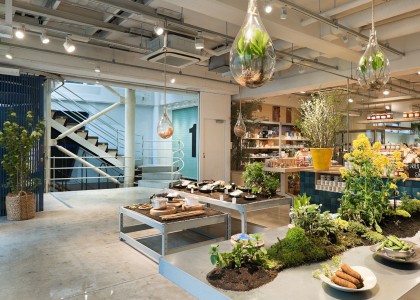
December 23, 2012

December 27, 2013

Partners & Friends

- Random Project
- Collaborate
Asakusa Culture Tourist Information Center
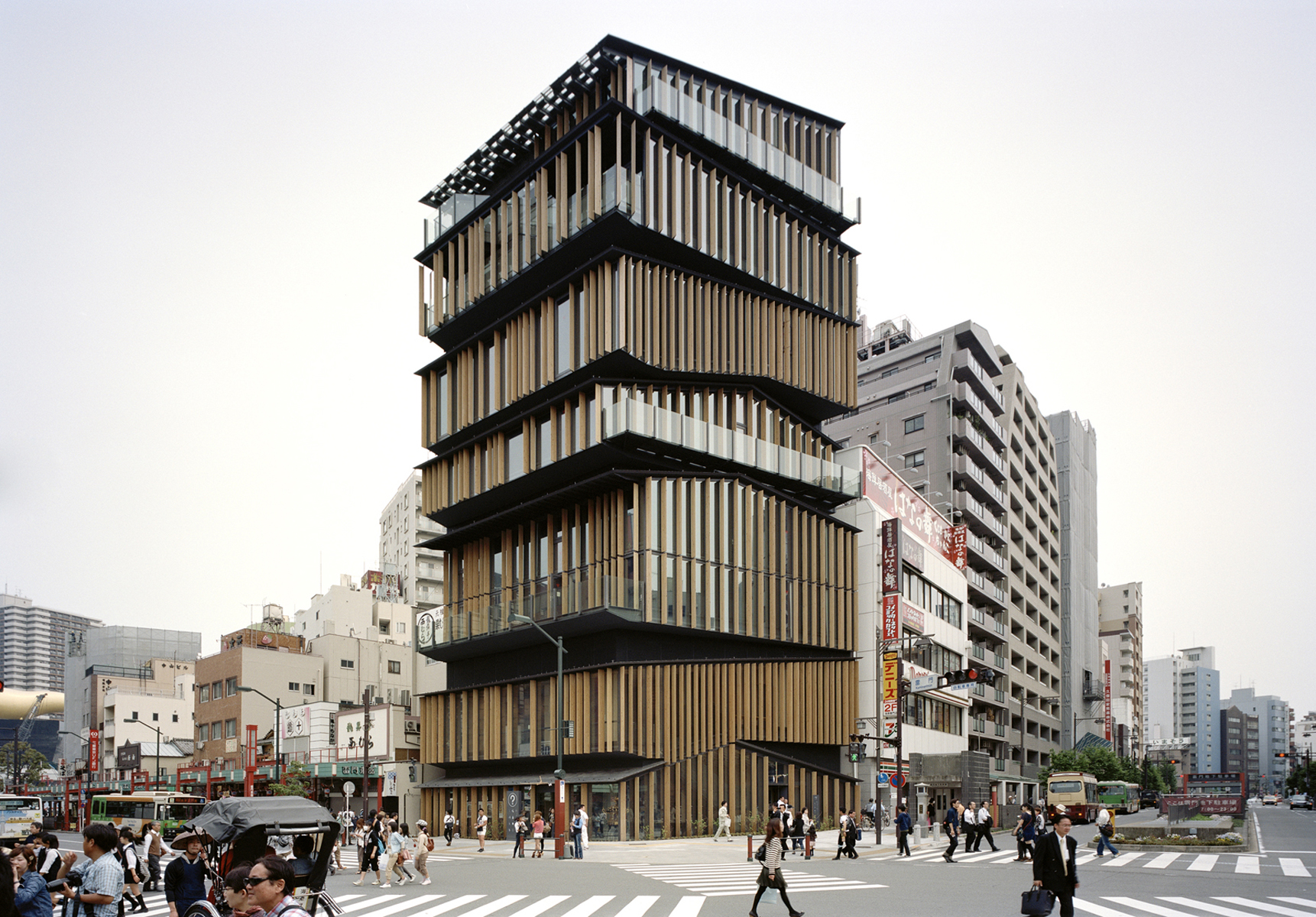
This image is available in several sizes: 250x250 pixels , 620x432 pixels , 1200x836 pixels , 1722x1200 pixels , or 1722x1200 pixels.
About this building
Asakusa Culture Tourist Information Center, designed by Kengo Kuma & Associates , is located at Asakusa, Taito, Tokyo, Japan. It was built in 2009-2012.
It is built on a 326,23m2 lot with a total built-up area of 2.159,52 m2.
Other people involved in the desing and construction process of the Asakusa Culture Tourist Information Center were:
- Makino Structural Design as Structural Engineer
- Izumi Okayasu Lighting Design as Electrical Engineer
- Taito City as Developer
- Yoko Ando, Kensaku Kato as Decorator
If you want to learn more about the Asakusa Culture Tourist Information Center, don't hesitate to check the full article ! Were you'll find a lot more information about it, including historical context, concept development, type of structure and materials used, and more.
This file contains additional information, probably added from the digital camera or scanner used to create or digitize it. If the file has been modified from its original state, some details may not fully reflect the modified file.
File History
- Things to Do
- Food & Drink
- Shopping & Style
- Coca-Cola Foodmarks
- Restaurants & Cafes
- Music & Nightlife
- Neighborhoods
- Los Angeles
Asakusa Culture Tourist Information Center
- Things to do
- price 0 of 4

Time Out says
It's hard to miss the stunning Asakusa Culture and Tourist Information Center designed by Kengo Kuma, located across the street from another visitor magnet, Sensoji Temple 's Kaminarimon gate. Besides offering free guided tours, currency exchange and an information desk, the eight-storey building also sports a (covered) observation deck, which offers the best views of Sensoji without having to jostle through the crowds.
You'll find exhibitions and cultural events on the other floors but if you're short of battery power best make a beeline for the street-facing counter on the second floor – it's fitted with electrical charging points.
Discover Time Out original video
- Terms of use
- Work for Time Out
- Time Out Group
- Advertising
- Modern slavery statement
- Manage cookies
Time Out Tokyo
- Magazine subscription
- Digital edition
- Buy the guide to Tokyo
Time Out products
- Time Out Worldwide
- Tokyo Cheapo (繁體中文)

Asakusa Culture and Tourism Center
The Asakusa Culture and Tourism Center is a distinctive seven-level building in Asakusa, directly opposite the famous Kaminarimon Gate of Sensoji Temple .
The Culture and Tourism Center is designed by famed architect Kengo Kuma and has a free observation deck and cafe on the 7th floor, with great views of Sensoji and Tokyo Skytree . It’s even made our list of top spots for a view of Tokyo .
On the ground floor is an information center with English-speaking staff.

- 5 Places to See Geisha in Tokyo
- Tokyo Skytree Guide: What to know before you visit
- 11 Fun Things to Do in Asakusa
- Best Free Viewpoints In Tokyo
- 183 m from Asakusa Station Ginza Line (G19) Asakusa Line (A18) Tobu Skytree Line (TS1)
- 0.6 km from Tawaramachi Station Ginza Line (G18)
- 0.8 km from Honjo-azumabashi Station Asakusa Line (A19)
Top Rated Tours

Cheapest Way to Transfer Your Money Out of Japan

Become a Samurai in Tokyo

Okinawa Airport Transfer from Naha to Hotel

Narita to Tokyo - Skyliner Discount Ticket

Should You Buy the Japan Rail Pass?

Dress up in a Kimono and Stroll around Asakusa
Other asakusa attractions.

Close without accepting
- Tours & Experiences
- Tailor-made Trips
- Bahasa Indonesia
We are happy to see you again!
Continue with
Or use email.
No Account? Create one
Create account
Already have an account? Sign in
Quickly Sign up with
I agree to Japan Travel's Terms of Service and Privacy Policy . Terms of--> and acknowledge that Japan Travel's Privacy--> applies to me.-->
Email reset password link
Please check your inbox and click the link we will send to you.
Asakusa Culture Tourist Information Center
- Share on Facebook
- Share on Twitter
- Copy link to share

The Asakusa Culture Tourist Information Center (浅草文化観光センター, Asakusa bunka kankō sentā) is an eight story building designed by Kengo Kuma. The top floor contains a free observation deck and a cafe with views onto Sensoji temple and the Nakamise shopping street.
Nearby Station
- Yamanote Line
Opening Hours
Phone number.
city.taito.lg.jp
Upcoming Events
Related articles.
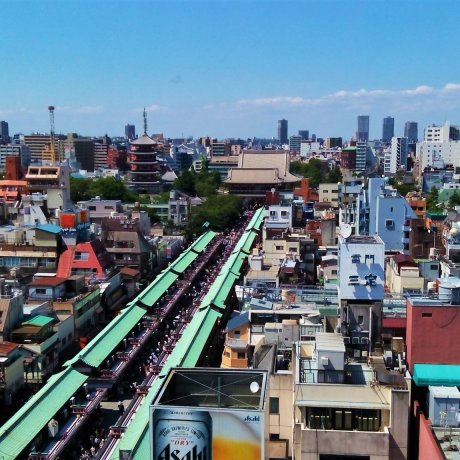

Asakusa Culture Tourist Information
Asakusa Culture Tourist Information Center has a view deck worth visiting and it is absolutely free.

Asakusa Tourist Information Center
Located in front of Kaminari-mon Gate, the Asakusa Culture Tourist Information Center is one of the biggest tourist information..

Miharashi Cafe
Do you plan to visit Asakusa in Tokyo and you are looking for an "out-of-the-way" spot or experience? I may have just the righ..
Why not review more places in Tokyo?
Help rate this location
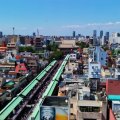
Your overall rating of this spot
Near asakusa culture tourist information center.
- Accommodation
- Restaurants
- Things to do
NOHGA HOTEL AKIHABARA TOKYO
NOHGA HOTEL AKIHABARA TOKYO is conveniently located in the midst of the electric town Akihabara, also known as the capital of manga and anime. In addition,..
Oakwood Premier Tokyo
Oakwood Premier Tokyo comes from a brand of standout luxury hotel & service apartments right at the heart of the Tokyo metropolis. It is located in the..

Asakusa Riverside Capsule Hotel
In Asakusa in central Tokyo, Riverside Capsule Hotel is a very inexpensive place to stay, convenient for sights, shopping and transportation...
Ayam-YA Halal Ramen Tokyo
Ayam-YA is a certified halal ramen restaurant found in the Okachimachi area of Tokyo, between Asakusa and Ueno, and not far from Assalaam Mosque. A sister..
Moomin House Cafe Tokyo Skytree Town Solamachi [Closed]
Enter the world of Moomin, the Finnish fairy-tale comic characters, in the exclusive Moomin Café in Tokyo Skytree Town. This permanent Moomin Café is..
Bunny Cafe Moff Rell
Bunny Cafe Moff Rell in Tokyo's Chiyoda Ward offers a chance to interact with adorable rabbits. You can make reservations for the cafe by phone, or..
Sensoji Temple
Senso-ji Temple (浅草寺, Sensōji) is a popular spot for omikuji, or fortunes. These auspicious sheets are offered in a multitude of languages, entic..
Tokyo Skytree
With a height of 634 meters, the Tokyo Skytree is Japan's tallest structure and a symbol of Tokyo. It is located in the northeastern part of Tokyo...
Tokyo Solamachi
Tokyo Solamachi is a shopping, dining and entertainment complex at the foot of the famous Tokyo Skytree. It has more than 300 shops and restaurants and..
Let us know how we can help.
Help us improve JapanTravel.com
We welcome any suggestions regarding this content. Your feedback is confidential and will be used to help improve this page.
Suggest an edit
https://en.japantravel.com/places/tokyo/asakusa-culture-tourist-information-center/570
Thank you for your support!
Your feedback has been sent.

Asakusa Culture Tourist Infomation Center
Visitor information, architectural information.
What's Nearby?
There is no other project within walking distance.
You might also fall in love with...
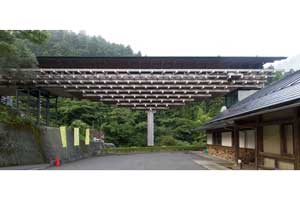
Space Design Concierge
ASAKUSA CULTURE TOURIST INFORMATION CENTER
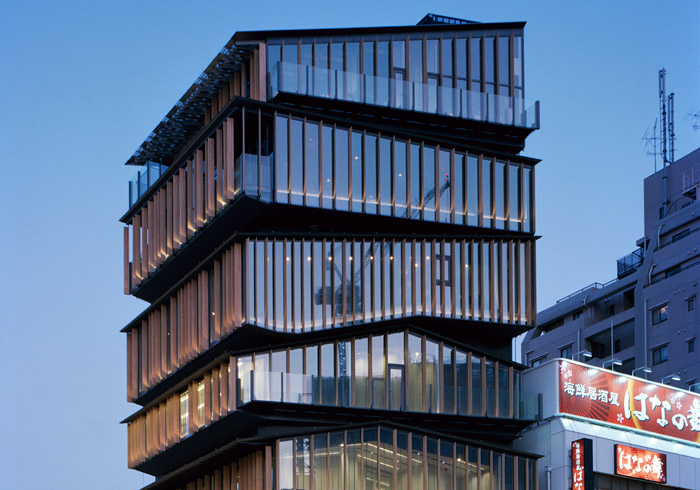
© Takeshi Yamagishi
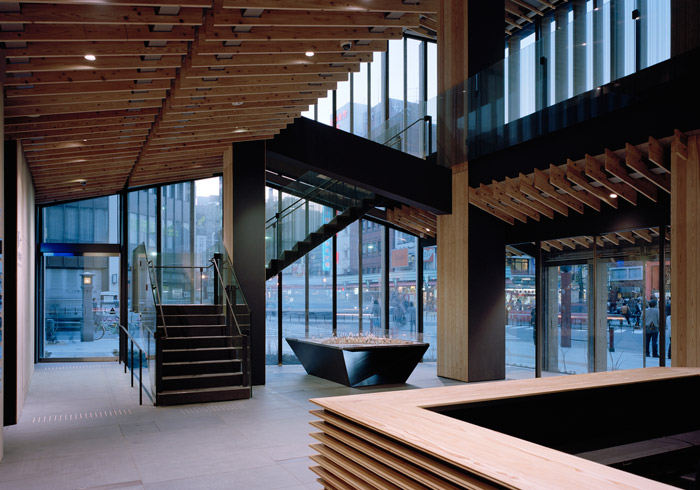
Tokyo Design Center inc. (TDC) Review
In the corner premise of just 326㎡ across Kaminari-mon Gate, the building was required to accommodate plural programs such as tourist information center, conference room, multi-purpose hall and an exhibition space. The center extends Asakusa’s lively neighborhood vertically and piles up roofs that wrap different activities underneath, creating a “new section” which had not existed in conventional layered architecture. Equipments are stored in the diagonally shaped spaces born between the roof and the floor, and by this treatment we could secure large air volume despite its just average height for high-and medium-rise buildings. Furthermore, the roofs not only divide the structure into 8 one-storied houses but also determine the role of each floor. First and second floor has an atrium and in-door stairs, creating a sequence from which you can feel the slope of the two roofs. On 6th floor, taking advantage of the slanted roof, we were able to set up a terraced floor with which the entire room can function as a theater. As angles of the roofs inclined toward Kaminari-mon and the heights from the ground vary from floor to floor, each floor relates differently to the outside, giving a unique character to each space.
Architectural design: KENGO KUMA & ASSOCIATES, Lighting design: Izumi Okayasu Award: Good Design Award 2012
- Tokyo Design Center inc. (TDC)
- Japan Design Consultants Association (JDCA)
Previous Page
- Login / Register
- You are here: Today
Tokyo Storeys: Tourist Information Tower by Kengo Kuma, Tokyo, Japan
23 October 2012 By Ken Tadashi Oshima Today

6/40 From certain angles the wooden slats of the facade predominate, cancelling out obtrusive reflectivity

7/40 From outside, the wooden slats allow the building to be read as ancient or modern, depending on your angle of approach

14/40 The wooden slats of the facade are continued within the building as exposed beams, a disconcertingly antique feature in such a modern structure, referring to the vernacular building tradition of Tokyo

16/40 The wooden slats of the facade are continued within the building as exposed beams, a disconcertingly antique feature in such a modern structure, referring to the vernacular building tradition of Tokyo

17/40 The wooden slats of the facade are continued within the building as exposed beams, a disconcertingly antique feature in such a modern structure, referring to the vernacular building tradition of Tokyo

In a formerly shabby area of downtown Tokyo, a tourist information tower, with traditional wooden elements referring to a local temple, offers visitors new perspectives over the city
Rising eight storeys above the heart of Tokyo’s downtown Shitamachi area, the Asakusa Tourist Information Tower marks architect Kengo Kuma’s continued efforts to revitalise and reinvent traditional Japanese culture and urban space. This year, the Shitamachi area has witnessed a rebirth following years of economic decline, with the development of western Tokyo and the recovery operation in the wake of the devastating Tohoku Great East Japan Earthquake in March 2011.
Following the opening earlier this year of the 634-metre Tokyo Skytree as the tallest tower in the world, Kuma’s Asakusa Tower stands as the new symbol of the revitalised Taito Ward fronting the landmark Kaminarimon Gate to the famous Asakusa Sensō-ji temple, the oldest Buddhist temple in Tokyo.

Bridging centuries of sacred and profane worlds, the Asakusa Tower’s multi-canted roof structure is a conscious counterpoint to the dynamic evolution of the surrounding urban space. While the Asakusa Sensō-ji dates back to 645, the vibrant Nakamise-dōri street leading to it is said to have come about in the early 18th century when souvenir shops were permitted to line the approach.
The precincts also include the Nishinomiya Inari Shinto Shrine dating to 1727, a five-storey pagoda and the dominating Kaminarimon ‘Thunder Gate’ at the entrance. Although the temple was bombed and destroyed for the most part during the Second World War, it remains one of Tokyo’s most popular tourist destinations and is seen as a symbol of the city and nation’s post-war rebirth, and of peace.

Kuma’s competition-winning scheme for Asakusa is one of many of his efforts to rebuild aging buildings in Japan. He also has an ongoing preoccupation with the revival of Japanese industries and craft skills, now in decline since their peak decades ago. In his Chokkura Plaza project and Stone Museum he made use of traditional stone cutting techniques and promoted the appreciation of Ukiyo-e wood-block prints in his Museum of Hiroshige Ando through the use of slim wooden louvres (AR October 2001). For the Nezu Museum (AR April 2010), he reconceived the traditional oversailing roof to appear razor thin and situated the famed Kabukiza theatre in Ginza within a high-rise complex.
The Asakusa Tower stands as a beacon to welcome tourists from abroad and within Japan. While Asakusa is a top destination for Japan Tourist Bureau tours for foreign visitors, such traditional culture can remain equally foreign to a younger Japanese generation. The particular character of this district is sensed immediately upon arrival at the subway station through multiple images of the area’s festivals and historic structures illustrated on subterranean walls, which then continue up to the street. In this mileu, Kuma’s 38.9-metre tower serves both as a landmark and three-dimensional urban sign. Actual signage is limited to a discreet question mark at ground-level to entice those in search of further information.

The Tourist Information Tower reads as multiple layers of single-storey houses, an impression of domesticity reinforced by the wooden detailing. This also refers to the nearby wooden pagoda of Sensō-ji temple – an equally ahistoric structure, which was rebuilt after the war
The double height information lobby contains a tableau of maps, brochures, a large model of the Taito Ward, and large video screen with announcements and images of the district. In presenting Asakusa old and new, the centre provides wi-fi links to its web page and dynamic views of the busy urban crossing that subtly change as you ascend the winding stair to the upper mezzanine level. Along the way, you can view a model of a mikoshi portable shrine (originally a feature of the crossing that would emerge behind the opening face of a clock), and then look out to elevated views framed by the external wooden louvres of the central shopping arcade leading to Sensō-ji.
Set against the building’s urban presence and monumentality, the interior is a surprisingly intimate sequence of spatial experiences. Built on a site of only 326 square metres, Kuma’s tower adopts the ‘pencil building’ typology of many neighbouring slender towers. The built structure maintains the small-scale character of the historic Asakusa district as a series of one- or two-storey stacked volumes for small-to-medium conferences, seminars, group tour support, lectures, events and exhibitions, with a top level viewing deck and café.

The tower as realised is distinctly more solid than the initial transparent schematic model in its spatial fluidity of an open passage from the basement to the fourth levels depicted in the competition scheme. Yet in the end the haptic qualities of wood, stone, paper and steel appeal far more to visitors. Indeed the tower has many faces and expressions. From the exterior it could be read as the transposition of the horizontal urbanscape to a vertical stacked landscape.
By night it can be seen as an oversized andon lantern facing the famous red lantern across the street. In contrast to overt Japanese readings, the tower’s side section expresses the freedom of Loos’s raumplan - most explicitly in the stepped auditorium space stacked on top of the 5th floor large conference room. Gaps between the stacked volumes house the HVAC equipment to enhance the effect of the tower’s section.

Building on its almost cartoon-like character, the building’s graphics highlight this spatial clarity - especially useful in finding your way in using the enclosed stair and elevator. In fact from early on in his career, Kuma’s designs have had a strong monumentality, evident in works such as the M2 Building (1991), a homage to Adolph Loos’s Chicago Tribune competition entry with its oversize column massing.
The tower’s monumental yet playful character revives and recreates the areas’ fantasies of the fantastic, and how this relates to the religious character of Sensō-ji. The temple’s five-story pagoda was once juxtaposed with a timber-frame replica of Mount Fuji constructed in 1887 as an entertainment attraction (rather like Disneyland’s 1959 Matterhorn ride). Although this faux Fuji was torn down in 1889, the twelve-story brick Ryōunkaku tower featuring one of Tokyo’s first elevators provided new views of the area until it was destroyed in the 1923 Tokyo Earthquake.
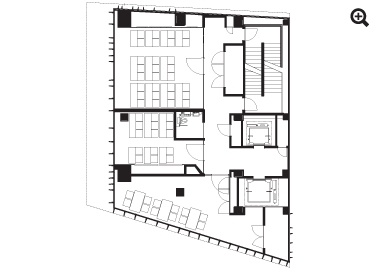
Scaffolding constructed around the pagoda also offered similarly dynamic views of the area for tourists in the pre-World War Two era. In effect, the Asakusa Tower recreates these vertical promenades to offer views of adjacent towers and landmarks including the Asahi Beer Company’s headquarter office tower rendered as a large beer mug with a faceted foam-like top and Philippe Starck’s adjacent beer hall with its golden flame hovering above.
Embedded in this context, the Asakusa Tower embodies multiple aspects of the area’s rich history, both sacred and profane, while providing new urban views and perspectives. Unlike the Tokyo Skytree with high admission fees, long lines, and remote panoramas from above the clouds, the viewing deck of the Asakusa Tower is free and offers vivid aerial vistas. Functioning brilliantly as a tourist information centre and urban signifier, it connects body and mind with Asakusa’s past, present and future.

Asakusa Tourist Information Tower
Architect: Kengo Kuma Lighting: Endo Lighting Lavatories: Toto Photographs: Edmund Sumner and Takeshi Yamagishi
November 2012

Since 1896, The Architectural Review has scoured the globe for architecture that challenges and inspires. Buildings old and new are chosen as prisms through which arguments and broader narratives are constructed. In their fearless storytelling, independent critical voices explore the forces that shape the homes, cities and places we inhabit.

Join the conversation online
Asakusa Culture Tourist Information Center


Asakusa Observatory
The observation deck at the culture and tourist information center .
Asakusa observatory is a terrace at the top floor of the area’s Culture and Tourist Information Center’s building, facing Kaminarimon in the north-east of Tokyo. It offers a unique view on the shopping street leading to the famous Senso-ji temple.
Asakusa area’s main attractions are Senso-ji temple and its surroundings, including its majestic Kaminari-mon gate, its main hall, and the long shopping street named Nakamise-dori. Facing this street, stands an 8-story building with an original architecture that gives a view on the crossroads.
The building designed by architect Kengo Kuma was inaugurated in 2012. It shelters on its ground floor Asakusa’s Culture and Tourist Information Center, with a multilingual reception desk (English, Chinese, Korean) as well as amenities such as a free Wi-Fi connection and toilets 🚽 . The upper floors are dedicated to office spaces and conference and exhibition rooms.
But its most interesting features are located at the top floor:
- Miharashi, a cosy café, and,
- The observation deck offering a great view on the temple’s surroundings up to Sumida river.
Visitors can enjoy here another urban scenery with a perspective on the district around Senso-ji and its pagoda. Slightly to the east, the view on Sumida Park is mostly hidden by buildings, but the Asahi Beer 🍺 Headquarters’ Flame is viewable. In the background, Tokyo SkyTree elegantly reaches to the sky.
- Flights and Airports
- Accommodation
- Transportation
- Internet & Phones
- Budget and money
- Japanese Food
- Visit with Kids
- Seasons: spring / summer / autumn / winter
- Weather forecast
- Time in Japan
- Holidays & Festivals
- Natural Disasters
- Customs and Duties
- Works and Closures
- From April 29 to 5 May -- Japanese Golden Week
- May 12 -- Mother's Day in Japan
- June 6 -- Beginning of the rainy season (Tsuyu) in Japan
- June 21 -- Summer starts in Japan
- July 1 -- Season start for climbing Mount Fuji
- From July 1 to 31 -- Gion Matsuri Festival in Kyoto with float processions on July 17 and 24
- Tokyo : Shinjuku , Shibuya , Harajuku , Asakusa , Akihabara , Odaiba , Ikebukuro , Ueno , Roppongi , Chiyoda , Ryogoku ...
- Around Tokyo: Kamakura , Nikko , Hakone , Mount Fuji , Mount Takao , Yokohama ...
- Kansai: Kyoto , Nara , Osaka , Mount Koya , Himeji , Kobe , Kinosaki , Kumano Kodo , Ise ...
- Japanese Alps: Kanazawa , Matsumoto , Takayama , Shirakawa-go , Nakasendo ...
- West: Hiroshima , Miyajima , Shikoku , Onomichi , Naoshima , Izumo , Kurashiki , Matsue ...
- South: Kyushu , Okinawa , Yakushima ...
- North: Hokkaido , Tohoku ...

- Temples and Shrines
- Gardens and Parks
- Hiking and Trekking
- Observation Decks
- Public Baths (Onsen and Sento)
- Festivals (Matsuri)
- Amusement Parks
- Visit on a Budget / Luxury

Keikaku is a travel agency specialist of Japan and providing different kind of services:
- Japan Rail Pass
- English speaking Guides
- Pocket Wi-fi
- Japan Nightlife
- Working in Japan
- Religion and Spirituality
- Arts and History
- Movies / Animated Movies
- Japanese Music
- Studio Ghibli
- Photos / Videos
- Weird Japan
- Translations
- Kana & Kanji
- Japanese Swear Words
- Honorific Suffixes (san, kun, chan...)
- Introducing yourself
- Thank you / Apologize
- Count / Say Your Age
- Say the Date / Tell the Time
- Happy birthday
- Enjoy Your Meal
- Writing your name

Kanas are the much-needed basic characters of written Japanese language. Memorize them at a fast pace with our method.

Ask any kind of question and share your knowledge about Japan in Kanpai’s community space, our Q&A section Kotaete.

Isshoni means "together" in Japanese: share your trip details (dates, places you would like to visit) and find companions to travel in Japan.

Create your Kanpai account to manage your profile and view your participation history (questions, answers).

The Asakusa Cultural and Tourism Center designed by Kengo Kuma
Kengo Kuma is probably one of the few contemporary Japanese architects that expressly pursue Japanese-ness in his/her works. He often uses natural materials such as wood in the spirit of traditional Japanese architecture, which knew how to turn seemingly unfavorable qualities of natural materials such as subtlety, delicacy, or weakness into beauty such as softness, transparency or flexibility/editability.
It that sense, it was fitting that he designed the Asakusa Culture and Tourism Center, which is located right in front of the Senso-ji and Nakamise Shopping Street, one of Tokyo’s most touristic areas for its Edo-era (1603-1868) architecture, heritages and atmosphere.
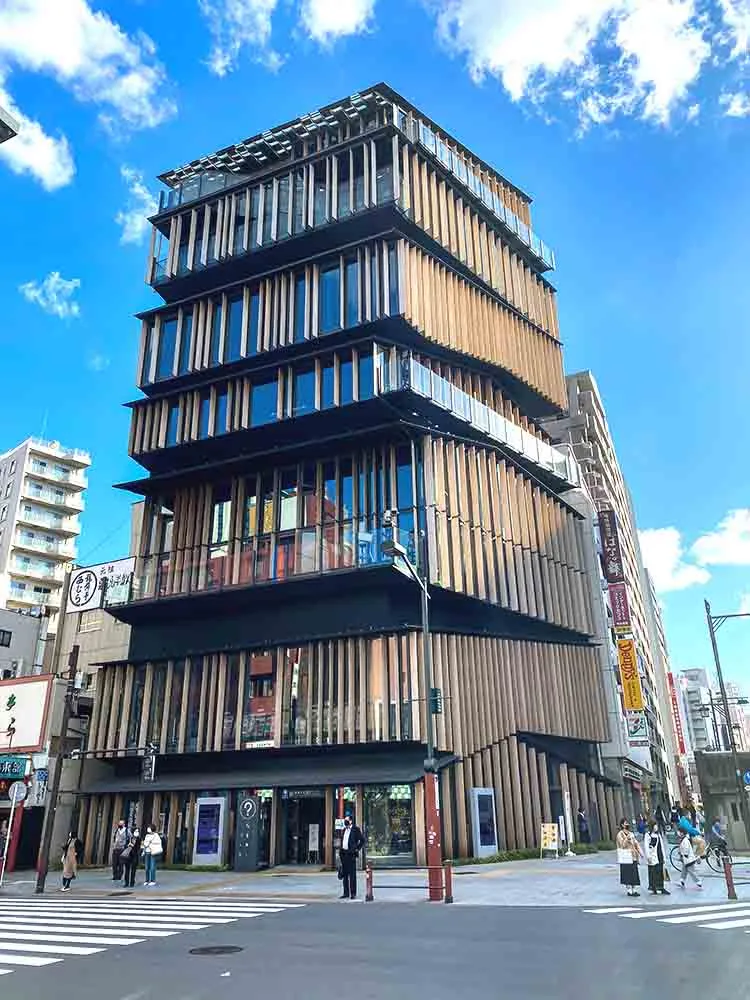
Before modernization, Tokyo was called Edo, and Edo was one of the largest cities by 1800 even without the Industrial Revolution. As properties were very high in demand, ordinary people lived in “nagaya (long house),” single-story wooden, narrow multiplexes divided into small units in order to accommodate many families in one building. Rows and rows of nagaya filled narrow streets after streets, creating lively communities that fostered vibrant culture of people. Ukyo-e, one of the most popular Edo cultures, vividly captured people’s lives back then.
Kuma thought about nagaya when he designed Asakusa Tourism Center because it was what made people’s Edo, which is at the heart of Asakusa heritage. But as the center had be built on a small piece of land, he chose to stack single-story Edo-style houses on top of each other.

Each floor represents a wooden house with a unique shape. And as each roof is slanted and have deep eaves as traditional Japanese houses, stacking of them created asymmetric triangular voids between floors. Kuma installed/stored equipment using those spaces. “We are too used to the idea that the floors have to be flat, but I hope I was able to inspire people to re-think the relationships of buildings and floors,” Kuma says.
A nagaya-inspired building must leverage wood, you’d almost think. But wood hasn’t been a to-go material, especially for exteriors, in modern construction due to the fire code – as a matter of fact, Edo had been notorious as a city prone to fire as it was full of wooden buildings. But as Kuma was demined to use wood not only for the interior but also the exterior, he processed it to enhance fire resistance. “Thanks to the emerging technology, you can cover the exterior of a building that is as high as 40 meters,” Kuma says. He chose Japanese cedar, which is the most commonly used wood species in Japan today.

You can enjoy coffee or beer at the cafe at the top of the building. See the Senso-ji and Nakamise street outside the window?

Kengo Kuma designs “architectural accessories” for FENDI using traditional Japanese paper

Kengo Kuma’s small architecture: Nagaoka City Hall Aore

The Meiji Jingu Museum designed by Kengo Kuma (2): Irimoya Roofs

The Meiji Jingu Museum designed by Kengo Kuma

Kengo Kuma and Small Architecture: The Japan National Stadium

Kengo Kuma:”small” architecture and traditional Japanese houses

The Haruki Murakami Library and its architecture by Kengo Kuma

Kengo Kuma and Small Architecture: Laminated Wood

The Takanawa Gateway Station designed by Kengo Kuma

Kabuki za architecture according to Kengo Kuma

Zuishoji: Kengo Kuma meets traditional Zen temple

Tents: tiny house for modern nomads

Tiffany Ginza designed by Kengo Kuma

Shibuya Scramble Square East designed by Kengo Kuma
Is kengo kuma’s architecture really sustainable.

kengo kuma: asakusa culture tourist information center
the overall architectural scheme has been developed in a way that each of the floors from the exterior is defined by varying roofs which extend from the center of the building, as if multiple volumes – 8 one-storied houses – have been piled on top of one another. the diagonally shaped spaces born between the ceiling and the ground of the level above, act as storage space for various equipment, and also secures large air volume despite its overall height for high and medium-rise buildings. these not only divide the establishment, but determine the various programs housed within.
the first and second floor has an atrium and in-door stairs, creating a sequence from which you can feel the sloping of the two storeys. the 6th takes advantage of its slanted roof, whereby a terraced plane allows the entire room to function as a theater. as the angles of the roofs incline towards kaminari-mon, with the heights from the ground varying between the stacked volumes, they all relate differently to the outside, giving a unique character to each space.
architecture in japan (1496)
Architecture in tokyo (313), kengo kuma (262), product library.
a diverse digital database that acts as a valuable guide in gaining insight and information about a product directly from the manufacturer, and serves as a rich reference point in developing a project or scheme.
- architecture in norway (176)
- carbon neutrality? (149)
- residential architecture and interiors (3834)
- snohetta (179)
- where people work (853)
- architecture in the czech republic (136)
- brick architecture (306)
- christian kerez (4)
- architecture on stilts (79)
- fictional architecture (217)
- glass art and design (163)
- shipping container architecture (196)
- architecture in colombia (33)
- facades (242)
- school architecture and design (689)
- thomas heatherwick (103)
designboom will always be there for you

IMAGES
VIDEO
COMMENTS
Design Team:Kengo Kuma, Teppei Fujiwara, Masafumi Harigai, Okayama Naoki, Kiyoaki Takeda, Masaru Shuku, Erina Kuryu, Hiroaki Saito. City:Tokyo. Country: Japan. More Specs. Save this picture ...
The Center of Culture and Tourism Information was built near the outer gate of the ancient Buddhist temple Senso-ji, built in the sixth century in the lively Asakusa. Your e 2-18-9 Kaminarimon, Taito-ku, Tokyo, Japan . Unlike many other districts of the metropolis of Tokyo, Asakusa still retains traces of its history, with buildings dating from ...
This visitor centre in Tokyo by Japanese architects Kengo Kuma and Associates looks like a stack of smaller buildings with sloping roofs. Named the Asakusa Culture Tourist Information Center, the ...
Photographer Edmund Sumner. Located across across from the Kamiari-mon Gate of the old Buddhist temple of Sens?-ji, in the busy neighborhood of Asakusa in Tokyo, the cultural and tourist information center piles up small volumes of sloping roofs, generating a non-conventional layered architecture. Each space is designed and conceived in section.
Location. Asakusa Culture Tourist Information Center is located on the south side of Kaminariomon-dori Street, and is directly across from the Kaminarimon Gate. From Exit 1 of Tokyo Metro Asakusa Station on the Ginza Line it is a 1 minute walk. From Exit A4 of Toei Asakusa Station on the Asakusa Line it is a 2 minute walk.
The Asakusa Culture Tourist Information Center is a building primarily containing tourist facilities, amongst other amenities in the Asakusa district of Tokyo's Taitō ward. Along with its features, the building is also an attraction due to its architecture, as it was designed by Kengo Kuma, a noted architect.It is located directly across the street from the Kaminarimon and is open from 09:00 ...
Asakusa Culture Tourist Information Center Kengo Kuma and Associates as Architects (c) ... Furthermore, the roofs not only divide the structure into 8 one-storied houses but also determine the role of each floor. First and second floor has an atrium and in-door stairs, creating a sequence from which you can feel the slope of the two roofs. ...
ASAKUSA CULTURE TOURIST INFORMATION CENTER 2012. In the corner premise of just 326 m2 across Kaminari-mon Gate, the building was required to accommodate plural programs such as tourist information center, conference room, multi-purpose hall and an exhibition space. ... Furthermore, the roofs not only divide the structure into 7 one-storied ...
Asakusa Culture Tourist Information Center, 2 Chome-18-9 Kaminarimon, Taito, Tokyo 111-0034 ... Tokyo's most iconic structure will always be… Viewing Decks; Sunshine 60 Observation Deck. The observation deck in the Sunshine 60 building is on the 60th floor (251m above sea level) and provides 360° views of Tokyo. Mount Fuji can be seen in ...
Asakusa Culture and Tourism Center. In the corner premise of just 326 sqm across Kaminari-mon Gate, the building was required to accommodate plural programs such as tourist information center, conference room, multi-purpose hall and an exhibition space. The center extends Asakusa's lively neighborhood vertically and piles up roofs that wrap ...
Located in front of the Kaminari-mon Gate, the Asakusa Culture Tourist Information Center is one of the biggest tourist information centers in Tokyo. It has a number of facilities, provides all kinds of information, and the staff is unbelievably kind and friendly. Center offers services in four languages—Japanese, English, Chinese, and Korean ...
July 8, 2012. In the corner premise of just 326 m² across Kaminari-mon Gate, the building was required to accommodate plural programs such as a tourist information center, conference room, multi-purpose hall, and exhibition space. The center extends Asakusa 's lively neighborhood vertically and piles up roofs that wrap different activities ...
Asakusa Culture Tourist Information Center, designed by Kengo Kuma & Associates, is located at Asakusa, Taito, Tokyo, Japan. It was built in 2009-2012. It was built in 2009-2012. It is built on a 326,23m2 lot with a total built-up area of 2.159,52 m2.
Tokyo. View Website. 03 3842 5566. Asakusa Station (Ginza, Asakusa lines), exit 2 or A4. Free. 9am-8pm daily (observation deck 9am-10pm) It's hard to miss the stunning Asakusa Culture and Tourist ...
The Asakusa Culture and Tourism Center is a distinctive seven-level building in Asakusa, directly opposite the famous Kaminarimon Gate of Sensoji Temple.. The Culture and Tourism Center is designed by famed architect Kengo Kuma and has a free observation deck and cafe on the 7th floor, with great views of Sensoji and Tokyo Skytree.It's even made our list of top spots for a view of Tokyo.
The Asakusa Culture Tourist Information Center (浅草文化観光センター, Asakusa bunka kankō sentā) is an eight story building designed by Kengo Kuma. ... With a height of 634 meters, the Tokyo Skytree is Japan's tallest structure and a symbol of Tokyo. It is located in the northeastern part of Tokyo... Tokyo 1.3km away ¥1,800. Shopping
Asakusa Culture Tourist Infomation Center Kengo Kuma. Visitor Information. Hours: 9:00-20:00. ... Visitor Center: Structure: Concrete+Steel: Floor Area: 2,159 ㎡ / 23,239 sq ft: Floor count: 8F/1B: Completion Date: ... You might also fall in love with... Yusuhara Wooden Bridge Museum Kengo Kuma; Cultural Hiroshige Museum of Art Kengo Kuma ...
Furthermore, the roofs not only divide the structure into 8 one-storied houses but also determine the role of each floor. First and second floor has an atrium and in-door stairs, creating a sequence from which you can feel the slope of the two roofs. ... ASAKUSA CULTURE TOURIST INFORMATION CENTER Address 2-18-9, Kaminarimon, Taito-ku, Tokyo 111 ...
Rising eight storeys above the heart of Tokyo's downtown Shitamachi area, the Asakusa Tourist Information Tower marks architect Kengo Kuma's continued efforts to revitalise and reinvent traditional Japanese culture and urban space. This year, the Shitamachi area has witnessed a rebirth following years of economic decline, with the ...
Asakusa Culture Tourist Information Center. Address. 2-18-9 Kaminarimon, Taito-ku, Tokyo, 111-0034, Japan. Business Hours. 9:00 - 20:00 (Observation terrace closes at 22:00, Café's opening hours are from 10:00 to 20:00 (19:30 for last orders) [Days Closed]
The Observation Deck at the Culture and Tourist Information Center. Asakusa observatory is a terrace at the top floor of the area's Culture and Tourist Information Center's building, facing Kaminarimon in the north-east of Tokyo. It offers a unique view on the shopping street leading to the famous Senso-ji temple.
It that sense, it was fitting that he designed the Asakusa Culture and Tourism Center, which is located right in front of the Senso-ji and Nakamise Shopping Street, one of Tokyo's most touristic areas for its Edo-era (1603-1868) architecture, heritages and atmosphere. Before modernization, Tokyo was called Edo, and Edo was one of the largest ...
the 'asakusa culture tourist information center' in tokyo is situated on a corner lot of 326 square meters across from kaminari-mon gate. designed by kengo kuma & associates, the multilevel ...